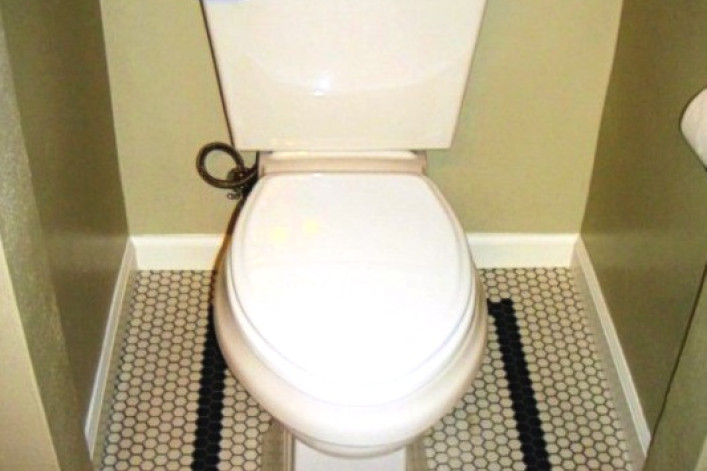NYC Renovation Questions: What's involved in replacing a toilet?

Q. I'm thinking about replacing my old toilet. What's involved in that? How much will it cost? Also I've recently heard of some fancy toilets like the Toto Neorest. What do you think about that?
A. Believe it or not, replacing a standard toilet is not too difficult or expensive. A handyman or even your super could probably change your toilet, but in New York City, by code, you must hire a plumber to do it.
“Legally, you must hire a licensed contractor to replace fixtures (anything permanent or built-in)," says master plumber Joseph-Marco Santullo of Systems 2000 Plumbing in NYC and Westchester.
The swap-out process involves removing the existing toilet, inspecting the plumbing and waste line to be sure nothing is leaking, installing the new toilet, and finally sealing it with caulking, says Alex Usharyov, a general contractor and founder of the NYC flat-rate home-improvement website Click and Improve.com.
You’ll need to refrain from using the loo for a few hours, but barring any leak-like complications, your new toilet should be up and flushing in no time.
All in all, says Usharyov, “replacing a toilet is not a lot of work. It can usually be done within two hours. Our licensed plumbers can do it for around $250."
As far as cult-inspiring high-end toilets like the Toto Neorest, which retail for about $5,000 and feature front and rear warm-water washing, an automatic air dryer and deodorizer, the labor is much more extensive because they require power to operate. You would need to hire a licensed electrician in addition to a plumber, Usharyov says. You'll also want to hire a contractor who has experience installing these.
(For anyone who doesn't know what the big deal is, be sure to visit the loo the next time you have dinner at Red Farm.)
Even if your budget allows for it, this luxury may not be an option in a New York City high-rise unless you’re remodeling the bathroom or can easily access power.
An outlet needs to be installed in back of the toilet and depending on the layout of your bathroom and the existing wiring, this could be a challenge or impossible without demolition.
Bottom line: These types of toilets aren’t practical to install when you’re simply switching out the fixture because of the amount of work that is needed, says Santullo. Save the Neorest for a renovation.
Here are a few more things to think about when replacing your toilet:
Round vs. elongated bowl
Check the dimensions of your existing toilet and get a toilet that matches as close as possible, unless of course you have more space to work with.
Round bowls are shorter (about 11” inside) and better for tight spaces. As the name implies, elongated bowls are longer (about 13” inside) and that extra two inches can make all the difference. In a NYC bathroom, you may not have the space to go longer without hitting your knees while sitting. Measure carefully.
Rough in
The "rough in" is the measurement where the toilet will sit in the bathroom and includes the placement of the waste outlet hole.
If you’re replacing your toilet, the existing rough in needs to match the specifications of your replacement toilet. There’s no fudging or changing that hole size, so get an accurate dimension before you select your new fixture.
To determine the distance, measure from the wall (not the baseboard if you have one) in back of the toilet to the center of the waste outlet hole (this should also be to the bolt caps on the toilet). Most will be 12", but some will be 10" or 14". Without accuracy, you’ll be making a trip to the home improvement store to return and buy another model.
Flushometer
In a pre-war unrenovated bathroom, your existing toilet is probably a Flushometer or one that has a lever that you can step on to flush, rather than a handle on the actual tank. You’ll see these in older buildings, as well as in commercial spaces.
A flushometer uses the water supply system for the flush rather than the force of gravity used by a conventional flush. The end result is less water usage and less clogging. You can replace the flushometer but if you’re accustomed to it, know that if you'll probably need some time to adjust to a conventional toilet.
Tracy Kaler was a designer, decorator and renovator in her last life. Before working as a freelance writer, she held several furniture sales jobs in the Big Apple and purchased a new wardrobe. Now she works in her pajamas and commutes two feet to her desk each day. This is one of the few advantages of living in a New York apartment, and well, so much for that wardrobe.
See All NYC Renovation Questions
Related posts:
NYC Renovation Questions: What should I know about converting a tub to a walk-in shower?
Ask an Expert: Can I get approved for a wet-over-dry renovation before I buy?
Introducing Click and Improve.com: Easy one-click home improvement & repairs for stressed-out urban dwellers (Sponsored)
NYC Renovation Questions: 6 great ideas you'll regret having
Sorry, you’ll have to move out for these projects (but maybe not for long)
NYC Renovation Chronicles: 5 ways to save on your bathroom renovation
NYC Renovation Chronicles: 5 essentials for renovating your bathroom
Making your bathroom sell-worthy






















